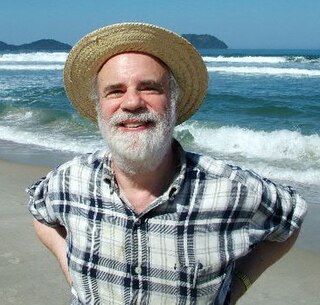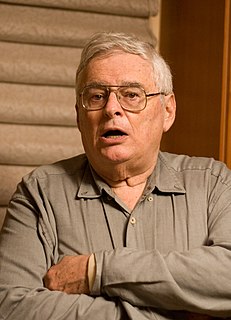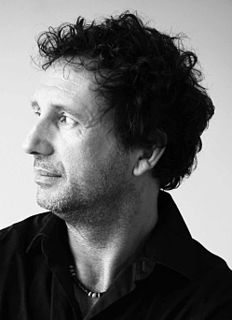Related Research Articles

Saul Aaron Kripke is an American philosopher and logician in the analytic tradition. He is a Distinguished Professor of Philosophy at the Graduate Center of the City University of New York and emeritus professor at Princeton University. Since the 1960s, Kripke has been a central figure in a number of fields related to mathematical logic, modal logic, philosophy of language, philosophy of mathematics, metaphysics, epistemology, and recursion theory. Much of his work remains unpublished or exists only as tape recordings and privately circulated manuscripts.

A thought experiment is a hypothetical situation in which a hypothesis, theory, or principle is laid out for the purpose of thinking through its consequences.
In natural languages, an indicative conditional is a conditional sentence such as "If Leona is at home, she isn't in Paris", whose grammatical form restricts it to discussing what could be true. Indicatives are typically defined in opposition to counterfactual conditionals, which have extra grammatical marking which allows them to discuss eventualities which are no longer possible.

David Kellogg Lewis was an American philosopher who is widely regarded as one of the most important philosophers of the 20th century. Lewis taught briefly at UCLA and then at Princeton University from 1970 until his death. He is closely associated with Australia, whose philosophical community he visited almost annually for more than 30 years.

Jerry Alan Fodor was an American philosopher and the author of many crucial works in the fields of philosophy of mind and cognitive science. His writings in these fields laid the groundwork for the modularity of mind and the language of thought hypotheses, and he is recognized as having had "an enormous influence on virtually every portion of the philosophy of mind literature since 1960." Until his death in 2017 he held the position of State of New Jersey Professor of Philosophy, Emeritus, at Rutgers University.
Counterfactual conditionals are conditional sentences which discuss what would have been true under different circumstances, e.g. "If Peter believed in ghosts, he would be afraid to be here." Counterfactuals are contrasted with indicatives, which are generally restricted to discussing open possibilities. Counterfactuals are characterized grammatically by their use of fake tense morphology, which some languages use in combination with other kinds of morphology including aspect and mood.

Nicholas Rescher is a German-American philosopher, polymath, and author, teaching at the University of Pittsburgh. He is chairman of the Center for Philosophy of Science and was formerly chairman of the philosophy department.
A possible world is a complete and consistent way the world is or could have been. They are widely used as a formal device in logic, philosophy, and linguistics in order to provide a semantics for intensional and modal logic. Their metaphysical status has been a subject of controversy in philosophy, with modal realists such as David Lewis arguing that they are literally existing alternate realities, and others such as Robert Stalnaker arguing that they are not.
In analytic philosophy, actualism is the view that everything there is is actual. Another phrasing of the thesis is that the domain of unrestricted quantification ranges over all and only actual existents.
Dorothy Margaret Doig Edgington FBA is a philosopher active in metaphysics and philosophical logic. She is particularly known for her work on the logic of conditionals and vagueness.
Modal realism is the view propounded by David Kellogg Lewis that all possible worlds are real in the same way as is the actual world: they are "of a kind with this world of ours." It is based on the following tenets: possible worlds exist; possible worlds are not different in kind from the actual world; possible worlds are irreducible entities; the term actual in actual world is indexical, i.e. any subject can declare their world to be the actual one, much as they label the place they are "here" and the time they are "now".
Gilbert Harman is an American philosopher, who taught at Princeton University from 1963 until his retirement in 2017. He has published widely in philosophy of language, cognitive science, philosophy of mind, ethics, moral psychology, epistemology, statistical learning theory, and metaphysics. He and George Miller co-directed the Princeton University Cognitive Science Laboratory. Harman has taught or co-taught courses in Electrical Engineering, Computer Science, Psychology, Philosophy, and Linguistics.

Judith Jarvis Thomson was an American philosopher who studied and worked on ethics and metaphysics. She is credited with naming, developing, and initiating the extensive literature on the trolley problem first posed by Philippa Foot. She was elected a member of the American Philosophical Society in 2019.
In philosophical logic, the concept of an impossible world is used to model certain phenomena that cannot be adequately handled using ordinary possible worlds. An impossible world, w, is the same sort of thing as a possible world , except that it is in some sense "impossible." Depending on the context, this may mean that some contradictions are true at w, that the normal laws of logic or of metaphysics fail to hold at w, or both.

Stephen Roy Albert Neale is a British philosopher and specialist in the philosophy of language who has written extensively about meaning, information, interpretation, and communication, and more generally about issues at the intersection of philosophy and linguistics. Neale is currently Distinguished Professor of Philosophy and Linguistics and holder of the John H. Kornblith Family Chair in the Philosophy of Science and Values at the Graduate Center, City University of New York (CUNY).
William G. Lycan is an American philosopher and Professor Emeritus at University of North Carolina at Chapel Hill, where he was formerly the William Rand Kenan, Jr. Distinguished Professor. Since 2011, Lycan is also Distinguished Visiting Professor of Philosophy at the University of Connecticut, where he continues to teach.
Two-dimensionalism is an approach to semantics in analytic philosophy. It is a theory of how to determine the sense and reference of a word and the truth-value of a sentence. It is intended to resolve the puzzle: How is it possible to discover empirically that a necessary truth is true? Two-dimensionalism provides an analysis of the semantics of words and sentences that makes sense of this possibility. The theory was first developed by Robert Stalnaker, but it has been advocated by numerous philosophers since, including David Chalmers.
John L. Pollock (1940–2009) was an American philosopher known for influential work in epistemology, philosophical logic, cognitive science, and artificial intelligence.
This is an index of articles in philosophy of language
In philosophy, similarity or resemblance is a relation between objects that constitutes how much these objects are alike. Similarity comes in degrees: e.g. oranges are more similar to apples than to the moon. It is traditionally seen as an internal relation and analyzed in terms of shared properties: two things are similar because they have a property in common. The more properties they share, the more similar they are. They resemble each other exactly if they share all their properties. So an orange is similar to the moon because they both share the property of being round, but it is even more similar to an apple because additionally, they both share various other properties, like the property of being a fruit. On a formal level, similarity is usually considered to be a relation that is reflexive, symmetric and non-transitive. Similarity comes in two forms: respective similarity, which is relative to one respect or feature, and overall similarity, which expresses the degree of resemblance between two objects all things considered. There is no general consensus whether similarity is an objective, mind-independent feature of reality, and, if so, whether it is a fundamental feature or reducible to other features. Resemblance is central to human cognition since it provides the basis for the categorization of entities into kinds and for various other cognitive processes like analogical reasoning. Similarity has played a central role in various philosophical theories, e.g. as a solution to the problem of universals through resemblance nominalism or in the analysis of counterfactuals in terms of similarity between possible worlds.
References
- ↑ Hunter, David (2010), "Stalnaker, Robert Culp", The Dictionary of Modern American Philosophers, Continuum, doi:10.1093/acref/9780199754663.001.0001, ISBN 9780199754663 , retrieved 2019-01-22
- 1 2 3 "Philosopher Robert Stalnaker solves problems the MIT way | MIT News". Newsoffice.mit.edu. 2015-03-20. Retrieved 2016-01-27.
- ↑ "Sections - British Academy". Britac.ac.uk. Archived from the original on 2016-02-06. Retrieved 2016-01-27.
- ↑ "John Locke Lectures - Faculty of Philosophy". Philosophy.ox.ac.uk. 2015-09-21. Archived from the original on 2007-08-29. Retrieved 2016-01-27.
- ↑ "Casalegno Lectures - La Statale" . Retrieved 2017-05-23.
- ↑ Pyke, Steve (2011-06-28). Philosophers. Oxford University Press. p. 188. ISBN 978-0-19-983186-9.
My philosophical preoccupation has been, and continues to be, the problem of intentionality the problem of saying what it is to represent the world in both speech and thought. The problem expands, since one can never fully disentangle questions about the nature of representation from questions about the nature of what is represented. We can describe and think about the world only with the materials we find in it.
- ↑ Stalnaker 2003; pp 27-28
- ↑ Peregrin, Jaroslav (2003). "Introduction" (PDF). Meaning: The Dynamic Turn. Elsevier. ISBN 978-0-08-044187-0. Archived from the original (PDF) on 2012-02-13.